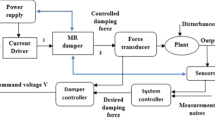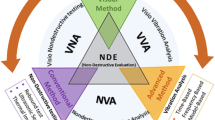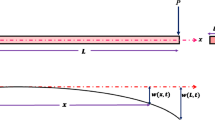Abstract
The system dynamic model is essential for chatter prediction in milling of thin-walled structures, which is largely affected by the estimation precision of dynamic modal parameters. This paper presents a method of dynamic modal parameter identification from response signals through operational modal analysis (OMA). To avoid omission of the modes and improve recognition accuracy, multichannel least square complex exponential (LSCE) method and multichannel autoregressive moving average (ARMA) method are applied to identify the modal parameters by processing multiple sets of response signals simultaneously. The convergence characteristics of the damping stability diagram at different natural frequencies are employed to eliminate the false modes caused by harmonics and model order. After that, the predicted stable boundaries of the milling system are estimated by an extended semi-discretization method, which incorporates the effects of multi-modes, multi-point contact, and regeneration chatter caused by the interaction between tool and thin-walled part. Through the milling experiment validation, it is shown that the dynamic modal parameters can be identified accurately, and chatter can be well predicted.
















Similar content being viewed by others
Availability of data and material
All data generated or analyzed during this study are included in this article.
References
Yang Y, Wan M, Ma YC, Zhang WH (2018) A new method using double distributed joint interface model for three-dimensional dynamics prediction of spindle-holder-tool system. Int J Adv Manufact Technol 95(5-8):2729–2745
Wu Y, Song Q, Liu Z, Wang B (2019) Stability of turning process with a distributed cutting force model. Int J Adv Manufact Technol 102(5-8):1215–1225
Yue C, Liu X, Liang SY (2017) A model for predicting chatter stability considering contact characteristic between milling cutter and workpiece. Int J Adv Manufact Technol 88(5-8):2345– 2354
Wang C, Zhang X, Liu J, Yan R, Cao H, Chen X (2019) Multi harmonic and random stiffness excitation for milling chatter suppression. Mech Syst Signal Process 120:777–792
Li D, Cao H, Zhang X, Chen X, Yan R (2019) Model predictive control based active chatter control in milling process. Mech Syst Signal Process 128:266–281
Altintas Y (2012) Manufacturing automation: metal cutting mechanics, machine tool vibrations, and cnc design
Merdol S, Altintas Y (2004) Multi frequency solution of chatter stability for low immersion milling. J Manuf Sci Eng 126(3):459–466
Insperger T, Stépán G (2004) Updated semi-discretization method for periodic delay-differential equations with discrete delay. Int J Numer Methods Eng 61(1):117–141
Ding Y, Zhu L, Zhang X, Ding H (2010) A full-discretization method for prediction of milling stability. Int J Mach Tools Manuf 50(5):502–509
Jiang S, Sun Y, Yuan X, Liu W (2017) A second-order semi-discretization method for the efficient and accurate stability prediction of milling process. Int J Adv Manufact Technol 92(1-4):583–595
Ding Y, Zhu L, Zhang X, Ding H (2010) Second-order full-discretization method for milling stability prediction. Int J Mach Tools Manuf 50(10):926–932
Huang C, Yang WA, Cai X, Liu W, You Y (2020) An efficient third-order full-discretization method for prediction of regenerative chatter stability in milling. Shock Vib 2020
Eksioglu C, Kilic Z, Altintas Y (2012) Discrete-time prediction of chatter stability, cutting forces, and surface location errors in flexible milling systems. J Manuf Sci Eng 134(6)
Zhang Y, Liu K, Zhao W, Zhang W, Dai F (2020) Stability analysis for milling process with variable pitch and variable helix tools by high-order full-discretization methods. Math Probl Eng 2020
Yan Z, Zhang C, Jiang X, Ma B (2020) Chatter stability analysis for milling with single-delay and multi-delay using combined high-order full-discretization method. Int J Adv Manufact Technol 111 (5):1401–1413
Yang Y, Zhang WH, Ma YC, Wan M (2016) Chatter prediction for the peripheral milling of thin-walled workpieces with curved surfaces. Int J Mach Tools Manuf 109:36–48
Dang XB, Wan M, Yang Y, Zhang WH (2019) Efficient prediction of varying dynamic characteristics in thin-wall milling using freedom and mode reduction methods. Int J Mech Sci 150:202–216
Sun Y, Jiang S (2018) Predictive modeling of chatter stability considering force-induced deformation effect in milling thin-walled parts. Int J Mach Tools Manuf 135:38–52
Song Q, Liu Z, Wan Y, Ju G, Shi J (2015) Application of sherman–morrison–woodbury formulas in instantaneous dynamic of peripheral milling for thin-walled component. Int J Mech Sci 96:79–90
Feng J, Wan M, Gao TQ, Zhang WH (2018) Mechanism of process damping in milling of thin-walled workpiece. Int J Mach Tools Manuf 134:1–19
Eynian M (2019) In-process identification of modal parameters using dimensionless relationships in milling chatter. Int J Mach Tools Manuf 143:49–62
Stepan G, Kiss AK, Ghalamchi B, Sopanen J, Bachrathy D (2017) Chatter avoidance in cutting highly flexible workpieces. CIRP Ann 66(1):377–380
Wang D, Löser M, Ihlenfeldt S, Wang X, Liu Z (2019) Milling stability analysis with considering process damping and mode shapes of in-process thin-walled workpiece. Int J Mech Sci 159:382–397
Oleaga I, Pardo C, Zulaika JJ, Bustillo A (2018) A machine-learning based solution for chatter prediction in heavy-duty milling machines. Measurement 128:34–44
Zaghbani I, Songmene V (2009) Estimation of machine-tool dynamic parameters during machining operation through operational modal analysis. Int J Mach Tools Manuf 49(12-13):947–957
Tunc LT, Ozsahin O (2018) Use of inverse stability solutions for identification of uncertainties in the dynamics of machining processes. Adv Manufact 6(3):308–318
Özşahin O, Budak E, Özgüven HN (2015) In-process tool point frf identification under operational conditions using inverse stability solution. Int J Mach Tools Manuf 89:64–73
Reynders E (2012) System identification methods for (operational) modal analysis: Review and comparison. Archiv Computat Methods Eng 19(1):51–124
Mohanty P, Rixen DJ (2004) Operational modal analysis in the presence of harmonic excitation. J Sound Vibrat 270(1-2):93–109
Bertha M, Golinval JC (2017) Identification of non-stationary dynamical systems using multivariate arma models. Mech Syst Signal Process 88:166–179
Yan R, Gao RX, Zhang L (2015) In-process modal parameter identification for spindle health monitoring. Mechatronics 31:42–49
Powałka B, Jemielniak K (2015) Stability analysis in milling of flexible parts based on operational modal analysis. CIRP J Manuf Sci Technol 9:125–135
Wan M, Feng J, Ma YC, Zhang WH (2017) Identification of milling process damping using operational modal analysis. Int J Mach Tools Manuf 122:120–131
Kim S, Ahmadi K (2019) Estimation of vibration stability in turning using operational modal analysis. Mech Syst Signal Process 130:315–332
Li B, Cai H, Mao X, Huang J, Luo B (2013) Estimation of cnc machine–tool dynamic parameters based on random cutting excitation through operational modal analysis. Int J Mach Tools Manuf 71:26–40
Poddar D, Shunmugam M (2019) Development of an automated modal extraction methodology through oma by random cutting excitation of a legacy milling machine. Mech Syst Signal Process 122:448–462
Jia P, Rong Y, Huang Y (2019) Condition monitoring of the feed drive system of a machine tool based on long-term operational modal analysis. Int J Mach Tools Manuf 146:103454
Peng Y, Li B, Mao X, Liu H, Qin C, He H (2018) A method to obtain the in-process frf of a machine tool based on operational modal analysis and experiment modal analysis. Int J Adv Manufact Technol 95(9-12):3599–3607
Brandt A (2019) A signal processing framework for operational modal analysis in time and frequency domain. Mech Syst Signal Process 115:380–393
Liang Z, Wang S, Qin C, Li C, Jiang X, Peng Y (2019) A time-synchronous-subtraction method for harmonics elimination in the operational modal analysis of machine tools. Proc Instit Mechan Eng Part C: J Mechan Eng Sci 233(17):6099–6111
Funding
This study is supported by the National Natural Science Foundation of China (51805116).
Author information
Authors and Affiliations
Contributions
Yue Zhuo and Zhenyu Han conceived and designed the study. Yue Zhuo, Jiaqi Duan, and Hongyu Jin performed the experiments. Yue Zhuo and Hongya Fu analyzed the data. All authors read and approved the manuscript.
Corresponding author
Ethics declarations
Conflict of interest
The authors declare no competing interests.
Additional information
Publisher’s note
Springer Nature remains neutral with regard to jurisdictional claims in published maps and institutional affiliations.
Rights and permissions
About this article
Cite this article
Zhuo, Y., Han, Z., Duan, J. et al. Estimation of vibration stability in milling of thin-walled parts using operational modal analysis. Int J Adv Manuf Technol 115, 1259–1275 (2021). https://doi.org/10.1007/s00170-021-07051-0
Received:
Accepted:
Published:
Issue Date:
DOI: https://doi.org/10.1007/s00170-021-07051-0




